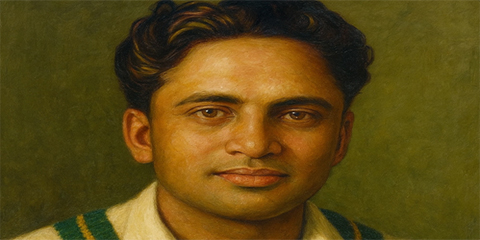Babar Azam's form slump: Inside the psychological battle and classical crisis of Pakistan's cricket maestro
JournalismPakistan.com | Published last month | Dr. Nauman Niaz (TI)
Join our WhatsApp channel
Pakistan's Babar Azam faces a career-defining form slump rooted in psychological pressure and the clash between his classical batting style and modern cricket's aggressive demands.Summary
ISLAMABAD — When the batsman loses his form, it is not his hands that forget; it is his mind that remembers too much. The cure is not to "find the old self" but to forget the one that tries to control the swing.
Pakistan played South Africa yesterday at Rawalpindi, and in that small arena of expectation and tension, Babar Azam returned, not as the conqueror, but as the seeker. His comeback was brief, the kind of brevity that lingers, counted not in overs or minutes but in the heart's hesitation. Cricket, that old and unyielding judge, can sometimes strip genius bare, reminding even its finest of the frailty that shadows form.
The Numbers Tell a Story of Struggle
Earlier in the week, during the second Test, he had lived through a sequence of beginnings that never became, 16 and 50, the outline of an innings without its soul. Each moment gleamed briefly before fading into the long silence that follows unfulfilled promise. At Lahore, too, he had managed 23 and 42, strokes fluent but hollow, as though some vital rhythm, that old quiet certainty of touch, had slipped through his grasp.
Now, in the West Indies, August 2025, the numbers tell their own story: 47, 0, 9 across three ODIs, the sort of sequence that stings not for its failure, but for the dissonance it carries against memory. Even the domestic stage offered little refuge. For Peshawar Zalmi in the Pakistan Super League X, the runs came as fragments: 16 against Lahore, then that incandescent 94 against Karachi Kings under floodlights, a night when the bat sang again, briefly, beautifully, as if remembering itself. Before that, 8 against Multan Sultans, 53 not out versus Islamabad United, a survivor's vigil more than a statement, a man walking through his own uncertainty, unbeaten yet uneasy.
It is not the absence of runs that unsettles, but the silence within them, the feeling that something luminous has dimmed. This is not the decline of skill, nor the failure of will, but a spell of stillness, a pause between two great songs. And yet, in that pause, the air thickens with unease. For Babar Azam, who once made batting feel like conversation with the divine, now stands at a strange threshold, his craft intact, his touch elusive. Something has turned within the music. Something quiet, something grave.
From Revelation to Scrutiny: The Weight of Expectation
There was a time when Babar Azam's batting felt like a revelation, an announcement of order in Pakistan's glorious chaos. His cover drive did not so much slice through the field as it did through the noise of the nation, fluent angles and dynamism that reminded us of what timing, grace, and patience could still mean in an age drunk on immediacy. He was not a batsman then; he was a mood, a delicate sentence the cricketing world was learning to pronounce with awe.
But awe is a fickle exchange in Pakistan. It turns to envy, then to exhaustion. One moment you are a symbol, the next you are debris under its reflections. The same critics that once sang Babar's name now chew on his shortcomings, mistaking the silence of his slump for arrogance, his restraint for indifference. The same eyes that once saw divinity now see defect because that, perhaps, is our national pastime: to love until the object of our affection begins to resemble our own failings.
The Burden of Comparison and Complicity
We never quite knew what to do with his talent. It arrived too polished, too self-contained, as if he had learned batting from the ghosts of the game rather than the streets of Lahore. We stood in awe, and then we compared because comparison is the easiest way to deny genius its individuality. We demanded he be a Sachin Tendulkar by morning, a Virat Kohli by dusk, forgetting that he was trying, quite earnestly, to be Babar Azam. And when he faltered under the weight of our invention, we turned on him with a cruelty disguised as critique.
Yet Babar is not without complicity. The solitude of stars has its temptations, to build walls from applause, to mistake isolation for focus, to cocoon oneself in the illusion of control. Somewhere between success and survival, he began to listen only to echoes that flattered him. The arrogance was not loud, merely quiet, the kind that hums beneath confidence until it becomes conviction, until it blinds. His mistakes were not spectacular, just human and that, in Pakistan cricket, is often the gravest sin of all.
Now, in this interlude of uncertainty, he must know what every great cricketer learns in time: that success has many fathers, and failure none. But perhaps this orphaned phase is necessary for reinvention often begins in solitude, when the applause fades and the game, stripped of glamour, begins to revisit its old, humbling truths once more. For all that has transpired, Babar Azam remains a sentence unfinished, its voice interrupted, not silenced. And maybe, in the quiet between his centuries and our expectations, he will find again that flow which first made us believe that rare lyricism of restraint, that unteachable poise, the limitless grace. Because sometimes, what goes wrong with Babar Azam is simply what goes wrong with all of us, brilliance met by burden, beauty strangled by the desire to define it.
Understanding the Mind: Psychological Mechanisms Behind the Slump
Let's, in a nuanced and pragmatic manner, try getting into what Babar may well have faced.
Psychological Mechanisms — The Mind Turning Inward
A world-class batsman never truly loses his ability overnight. The gift remains, sleeping, elusive, somewhere beneath the noise. What is lost is not skill, but access; the keys to the vault of instinct go missing. The unconscious, once a river flowing in perfect flow with the body, becomes dammed by the intrusion of thought.
Performance Anxiety and Overconscious Control
Under pressure, the kind that seeps in through slumps, scrutiny, and suffocating expectation, the mind begins to turn traitor. Movements once effortless are now dissected mid-motion. The hands, once moving in music with the ball, start listening to the chatter of the brain.
Sports psychologists call it reinvestment, when consciousness, drunk on fear, decides to micromanage what the body has long mastered. The result is inevitable: timing deserts, reaction dulls, the once-fluid symphony of muscle and instinct becomes a hesitant monologue.
Fear of Failure and Identity Crisis
For an elite athlete, performance is not what they do; it is who they are. So when the runs dry, the drought is existential. Each failure is not just a scoreless inning but a slow erosion of self. The body, flooded with cortisol and adrenaline, becomes its own saboteur. Muscles tighten, hands lose their whispering touch, perception narrows into panic. The more one fears failure, the more one invites it until the mind becomes a hall of mirrors, each reflection another reminder of what used to be.
Loss of Flow State
The most beautiful cricket, the kind Babar once played, belongs to a trance called flow. In it, time melts, noise fades, and the bat becomes an extension of thoughtless grace. But when self-consciousness creeps in, that sacred silence breaks. The batsman no longer plays the ball; he plays his own mind, and the mind, as ever, is a crueler opponent.
Depression or Burnout
And then comes the heavy stillness. The body slows, the eyes lose their brightness, the spark that once read bowlers a heartbeat early now flickers dim. Sports medicine calls it psychomotor retardation; we might simply call it exhaustion of the soul. Fatigue that is not physical but emotional, a dulling of anticipation, a flattening of joy.
The Body Mirrors the Mind: Sports Medicine Factors
The body, faithful that it is, mirrors the mind's unrest. In cricket, a game of millimeters and milliseconds, even the smallest physiological tremor can rewrite the script.
Altered Motor Patterns / Muscle Memory Interference
Chronic stress rewires the neural map. The pathway that once produced a perfect cover drive becomes fuzzy, the synapses less sure. Coordination between what the eye perceives and what the hand performs begins to desynchronize. The art that once flowed like water now stutters like static.
Proprioceptive Disruption
Fatigue blurs the body's internal direction. The batsman's limbs no longer speak the same language. The sense of where the bat is in space falters by fractions, and in cricket, fractions are fate. A millisecond too early, a degree too open and beauty turns to error.
Vision & Eye Fatigue
Anxiety tightens even the tiniest muscles, including those behind the eyes. The world narrows into tunnel vision. Hand-eye coordination that sacred synchrony depends less on what one sees than on when one sees it. Stress, invisible yet potent, distorts this rhythm; timing frays.
Overtraining or Central Fatigue
When the grind becomes unrelenting, the central nervous system begins to sag under its own fatigue. Dopamine, the silent hum of motivation and movement, starts to fade. The body feels fine, yet the mind moves through fog. Reaction slows; spirit dulls. The player feels "off," not broken, but blurred.
Externalisation of Internal Turmoil
When the inner landscape turns to storm, the bat becomes its barometer. It trembles with the weather of the soul. The body begins to articulate what the tongue cannot bring itself to confess. A tremor before the stroke, a foot that moves too soon, a bat held for a heartbeat too long, these are not technical flaws, but emotional signatures etched into motion. The conscious mind, desperate to reclaim what it has lost, seizes the wheel from instinct. And in that seizure, that small act of rebellion against the self, timing, that most fragile of cricketing virtues, is the first to die.
Psychological Recalibration
Healing begins at the moment of surrender when struggle is acknowledged, not denied. Mindfulness and acceptance-based therapies teach the player to watch the storm of thought rather than fight it. Cognitive reframing tilts the axis of perception: success becomes process, not product; the journey, not the scoreboard. With the right guide, a sports psychologist fluent in both science and empathy, imagery, language, and ritual can become quiet anchors. Through them, confidence is coaxed back not from applause but from within, where it always truly lived.
Rebuilding Flow
To return, one must simplify. Strip the act of batting down to its innocence, to the flow, middling the ball, taking it on the center of the bat in a forgotten net, far from eyes and expectation. In practice, let go of averages, rankings, reputation, these are metrics of the world, not of joy. Constraint-led drills, one-handed exercises, eyes-closed visualisations, these are not gimmicks but gateways. They reawaken the instinctive self, the boy who once batted in fading light because he could not bear to stop. To play again, not perform.
Neuromuscular Repatterning
Gently, almost musically, the body must learn to trust itself again. The damage of pressure is not undone by force, but by rhythm, by the steady, patient relearning of grace. Low-intensity drills become caresses of memory, teaching the muscles what fear once stole.
Cross-training in yoga, in tai chi, in dance restores proprioception, balance, and the sense of the body's own music. Somewhere in that slow rediscovery, between breath and movement, between silence and motion, the artist will find again his rhythm that effortless hush which once preceded brilliance.
Perhaps this, then, is the unseen battle of Babar Azam, not fought between bat and ball, but between silence and noise, instinct and interference, grace and sobriety. The tragedy, and the beauty, lie in how perilously close they live together.
Rest & Recovery
Sometimes healing demands absence. A complete withdrawal, not as retreat, but as renewal. A full break from cricket to let the brain's motor networks breathe, to allow what sports scientists call neural de-loading. Sleep, sunlight, sustenance, the trinity of repair. Optimising rest, nurturing with omega-3s, B vitamins, magnesium, giving the body back its chemistry of calm. Because before confidence returns, the nervous system must first learn stillness.
Spiritual Reconnection
And finally, the return that transcends technique, the reconnection not of muscle but of meaning. At the poet's level of seeing, the batsman must be reminded: he is not his form, nor his runs, but his presence. When ambition softens, when fear dissolves, when the noise of validation fades, the bat becomes once more an extension of being. The act of batting ceases to be performance and returns to what it once was, prayer in motion.
The Disquiet of a Classical Virtuoso
There are certain cricketers whose bats speak in complete sentences, precise, elegant, unfussy. Babar Azam has always been one of them, his batting less a display of power than of persuasion, a dialogue between touch and timing. Watching him at his best was to see order imposed on chaos, the still head, the seamless balance, the cover drive carved like calligraphy. He was a traditionalist in a world turning neon, a Mozart in an age of synthesizers.
But modern cricket, with its insatiable appetite for reinvention, has little patience for such purity. It is a game now addicted to noise, where the art of accumulation is mistaken for inertia and restraint for timidity. Somewhere in this new gospel of power-hitting and algorithmic aggression, Babar found himself cornered, a craftsman told to become a showman, a classical lyricist asked to write jingles. Imagine Mozart being told to adopt jazz; imagine a classical singer coerced into pop. The problem is not capability; the artist can adapt, but the essence. The beauty of classical form lies in its surrender to structure, its conversation with time. To force it into modern rhythm is to disrupt that balance, to ask grace to masquerade as spectacle. And that, perhaps, is where Babar began to lose footing, not in technique, but in truth.
For years, his batting had been a meditation, a study in stillness and flow. Now, it has become a negotiation between the self and the demand. Analysts wanted more intent, captains wanted acceleration, critics wanted volume over melody. Every ball became a referendum on his adaptability, every innings a test of his willingness to conform. In trying to be everything, he began to drift away from the one thing he had always been, himself.
The tragedy of great artists is not failure but dilution. Babar's slump was not a collapse of ability; it was a crisis of identity. His rhythm, once anchored in instinct, now sought validation from noise. The delicate geometry of his strokes that hushed precision through the covers began to fray under the weight of expectation. He was still making runs, yes, but they lacked the music. The sound had changed.
There's something profoundly lonely about watching a purist perform compromise. You can see the conflict in the footwork, the hesitation before commitment, the mind thinking two thoughts at once. Cricket, like art, punishes doubt more than error. And Babar's doubt was existential: to remain true or to remain relevant? Why, one must ask, should a batsman of such pedigree be compelled to change at all? Why must classicism apologize for not being modern? In every era, there should be room for the timeless for the batsman who caresses rather than bludgeons, who constructs beauty rather than chaos.
Perhaps Babar's journey is not decline but resistance, the artist holding his ground against fashion. Because even in his struggle, there remains that unmistakable grace, a reminder that cricket, like music, will always need its Mozarts, even in a world obsessed with jazz.
The Rise of a Pakistan Cricket Icon
Babar Azam emerged quietly, the way some storms do, not announced, not heralded, but inevitable. A right-handed batter whose cover drive carried the kind of elegance that made fielders pause, he became the mirror of Pakistan cricket for a decade: precise, composed, unflinching. The late 2010s and early 2020s were his; the country's hopes, for a time, seemed to move in tandem with the arc of his bat. At 21, fresh from the disciplined grind of age-group cricket and a home debut that began with a fifty against Zimbabwe, he announced himself in a way few do: a hat-trick of ODI hundreds against the West Indies in 2016. It was not just talent, it was audacity, a claim staked for permanence in Pakistan's fragile white-ball lineups.
The call to Test cricket followed swiftly. By the time Younis Khan and Misbah-ul-Haq passed the baton, Babar had already begun to sculpt his place in the narrative of Pakistan's next great batter, a baton of promise, steadiness, and quiet authority. Born in Lahore, cousin to the Akmal brothers, he came through the long, winding corridors of Pakistan's junior system: Under-15s in 2008, U-19 World Cups in 2010 and 2012, where he emerged as Pakistan's top scorer both times, a young man steadying himself on the rickety scaffolding of domestic cricket. His ascent was a counterpoint to the chaos of a team starved for batting consistency, a symphony of runs where others offered only noise.
Career Milestones and Leadership
By 2018, milestones had become markers of inevitability. He was the joint second-fastest to 2,000 ODI runs, the fastest to 1,000 in T20Is, and a leading century-maker for Pakistan. His hundred against New Zealand in a must-win 2019 World Cup game remains stamped in memory: clinical, composed, the kind of innings that carries a nation's breath in its swing. Test cricket, slow to bend to his will, eventually succumbed: from early 2018 through the end of 2022, Babar struck a purple streak unparalleled by any Pakistani batter. Nearly 9,000 runs across formats, a quiet, relentless accumulation of mastery, the hum of form unbroken. His peak came in 2022: among the world's top three batters in Tests and ODIs, 1,184 Test runs in a year, four centuries, a ten-hour 196 against Australia that read like a textbook in patience and precision.
The mantle of captaincy arrived as naturally as a shadow at sunset. By the end of 2020, he was Pakistan's leader across formats. Yet cricket, like life, is rarely linear. The 2023 World Cup, a disappointing run, and a faltering period in red-ball cricket all conspired to bring scrutiny. His form waned; a solitary Test fifty over two years, averages dipping into unfamiliar territory. By late 2023, amid the chaos of Pakistan cricket's leadership carousel, he stepped down from the captaincy, a reluctant retreat, but one that belied the quiet weight of his achievements. Imran Khan aside, he remained Pakistan's most successful all-format captain.
By mid-2025, Babar remained a senior presence, a steadying force, yet the automaticity of his selection had faded. The storm he once carried, the certainty that defined him, now tempered with reflection. The brilliance, though quieter, lingered, proof that the lyrics of a career are measured not just in runs or records, but in the arcs, pauses, and crescendos of a life spent at the crease.
Career Statistics: A Testament to Excellence
Babar Azam walks to the crease, a quiet promise in his stride, and the numbers follow like the echo of his bat. In Tests, he has stepped onto the green battlefield 61 times, innings stretching beyond the century mark 112 times, and yet nine not-outs whisper of the patience that underpins his artistry. He has amassed 4,366 runs, a highest score of 196 that teeters on the edge of immortality. Averages of 42.38 speak of consistency, yet fail to capture the elegance with which he caresses each delivery. With 513 boundaries and 23 sixes, the scoreboard only hints at the rhyme in his footwork, the rhythm in his wrists, and the timing that leaves bowlers chasing shadows. Forty-eight catches, silent, sure-handed, are punctuation in his symphony.
In ODIs, 134 matches become a canvas where 6,291 runs are painted with the brushstrokes of 19 centuries and 37 fifties. His average, a luminous 54.23, glows against 7,179 balls faced, and a strike rate of 87.63 measures not just runs but the gentle acceleration of intent. He cuts through the field with 580 fours, 68 sixes, and 58 catches, weaving a narrative of authority and grace, each innings a stanza in a longer poetic script of the game.
T20 Internationals compress his genius into bursts of brilliance. In 129 matches, he has played 122 innings, not out 15 times, carving 4,223 runs from 3,270 deliveries. His highest, 122, a fleeting yet unforgettable crescendo. An average of 39.46 paired with a strike rate of 129.14 speaks of controlled fire, three centuries and thirty-six fifties marking moments when the cricketing world stops to watch him dance. Four hundred forty-seven boundaries, 73 sixes, fifty-two catches, they are more than statistics; they are the punctuation of aesthetics in motion.
Across first-class cricket, 98 matches and 167 innings have yielded 6,418 runs, a towering 266 the peak of patient artistry. Twelve centuries, forty-two fifties, 787 fours, seventy catches, they record the unfolding of a craftsman in the long game, a man for whom time bends to the shape of the innings. List A cricket and domestic T20s are the theaters of his dominance: 202 matches and 9,437 runs, 30 centuries, 56 fifties in List A, and 321 T20s yielding 11,330 runs with 11 centuries and 93 fifties.
Boundaries and sixes, 896, 85 in List A; 1,196, 214 in T20s become the stanzas of his relentless narrative, the musicality of cricket distilled into numbers that pulse with rhythm, a heartbeat audible only to those who look beyond digits, just digits. In every format, in every innings, Babar Azam is more than statistics. He is a lyric in motion, a metronome of elegance and intent, the calm eye in cricket's storm, a storyteller who uses cricket as a tool, footwork and fielding, to etch moments of quiet grandeur on the scorecard of history.
Dr. Nauman Niaz is a civil award winner (Tamagha-i-Imtiaz) in Sports Broadcasting & Journalism, and is the sports editor at JournalismPakistan.com. He is a regular cricket correspondent, having covered 54 tours and three ICC World Cups, and having written over 3500 articles. He has authored 15 books and is the official historian of Pakistan Cricket (Fluctuating Fortunes IV Volumes - 2005). His signature show, Game On Hai, has been the highest in ratings and acclaim.

























